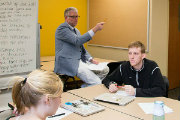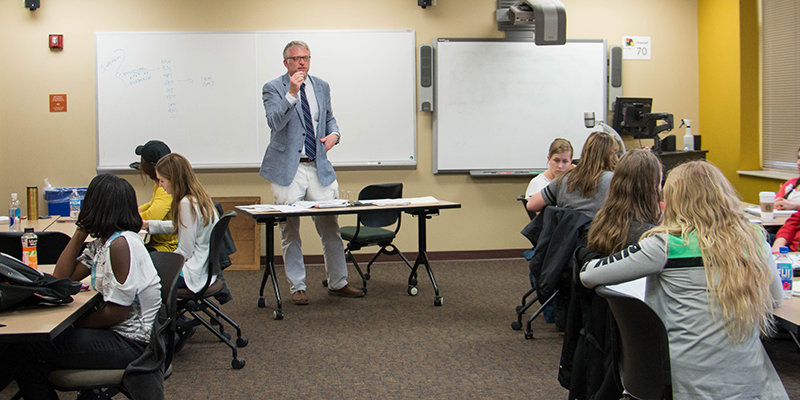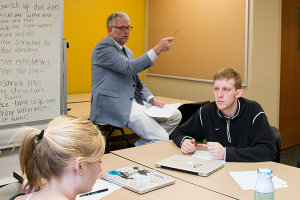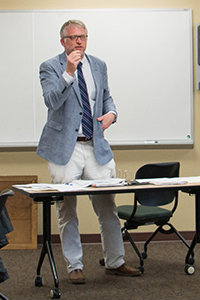Miami University Students Identify Solutions to End Campus Racism


James M. Loy, Miami University
The class, comprised mostly of future educators, was posed a single question. One that Miami University itself had expressed an interested in solving.
“What can Miami do to eradicate racism on campus?” Thomas Misco, a professor of teacher education in Miami’s College of Education, Health and Society (EHS), asked his social studies methods students.
It was a question motived by the many ongoing efforts around campus to create more respectful and inclusive environment for everyone, which presented an opportunity, Misco thought, to allow students to take the lead in seriously thinking through this pressing social issue.
He planned the exercise to be completely student driven. The class would also invite outside EHS experts to simulate a community meeting-like environment. And it would coincide with a strategic instructional lesson that highlighted the key differences between a debate and a deliberation.
To prepare, students were free to comb through a website called The Demands, which archives hundreds of student calls to end systemic racism and intolerance on college campuses across the nation. As a class, they generated a list of about 20 ideas that they felt were the most relevant to their experiences as college students.
Five student groups were then formed and each group identified one topic from the long list of class-generated ideas. Next, every student found a relevant reading related to their particular group topic, selected from a wide range of current articles from popular publications that included the New York Times, Education Week, and more. 
Finally, each group was asked to narrow down all these readings further, to select only one to be shared with the rest of class. This resulted in the curation of five strong articles -- one from each group -- to be used as a starting point for a productive dialogue on ending systemic campus racism.
Then they came to class, ready to deliberate.
The Day of Deliberation
“Debate is acrimonious,” Misco says at the beginning of class. “It is adversarial. You have a clear winner and a loser. And most of time, if we are trying to solve problems -- and that’s what citizens try to do -- debate doesn’t work that well.”
But deliberation, he explains, is about being open minded. It’s about entertaining and interrogating all ideas. It’s about reflecting critically and then rejecting certain ideas when necessary.
“You need to listen,” says Misco. “You need to reason. You need to create a dialogue. It’s okay to have conflict. This is not a straightforward activity. You need to apply judgement. We need to look to variability and diversity to bring in perspectives that ultimately help us solve the problem.”
After these opening remarks, the groups position themselves into small circles and begin to deliberate on the class readings, which focus on ethnic studies, inclusion training, Greek life, punishing bigotry, and increasing diversity.
And at first, the conversation starts at a low hum, as some students are more comfortable taking the lead, while others simply listen and consider. But then, as more and more students start to engage, the room’s volume begins to rise, which makes the deliberation quite lively and, at times, even charged.
“A lot of times the response to racism seems like it is dealing with it after it happens. It’s very reactionary,” is comment that clearly floats momentarily above the rest.
And, “I think it is a huge problem on how to get people to take it seriously,” is another.
Soon it is almost impossible to identify a student that isn’t participating to some degree.
The Solution(s)
Toward the end of class Misco calls for everyone to reconvene. “So please bring your best imperfect solution and be prepared to share it,” he says. But eventually, instead of one single solution, they settle on two.
The first is a call for more substantive and reoccurring diversity training. Because, according to the students, the current university training is often far too brief, too limited, and impractical.
 “A solution needs to be something that is consistently done,” one student says. “Because if you only talk about it once in a class your freshman year, then it devalues it. There also needs to be a thorough analysis of the training that students go through. Many of the scenarios are very unrealistic and don’t really work. There should also be thorough research to examine how racism is happening around campus, and how people are reacting, so we can have some sort of training that is substantial.”
“A solution needs to be something that is consistently done,” one student says. “Because if you only talk about it once in a class your freshman year, then it devalues it. There also needs to be a thorough analysis of the training that students go through. Many of the scenarios are very unrealistic and don’t really work. There should also be thorough research to examine how racism is happening around campus, and how people are reacting, so we can have some sort of training that is substantial.”
The second solution focuses on what the students see as a need for more action and accountability.
“My group focused on the inaction of the administration when it comes to dealing with students who have displayed some sort of racist behavior,” says another student. “You can have a talk with a person and you can send an email out to the whole campus. But you really can’t then expect everyone else to do better from that.”
At the end of class, Misco also sought general comments from the participating EHS experts -- which included EHS professor of education and department chair Brian Schultz, former EHS assistant dean for research and diversity Ray Terrell, and Miami alumna and Cincinnati Public School teacher Rachel McMillian -- who all commend the students for their willingness to engage with this difficult subject.
“I love that you are modeling deliberation, to have a space where you are challenging the notion that there’s some capital ‘K’ knowledge that we are going to get because a teacher is giving it to you,” says Schultz.
“And in terms of this topic,” he continues, “I think it’s pretty powerful. If we want to challenge and change the racist actions that are happening, we need to look within all of us. If we are going to teach this, and bring this into focus, then faculty have to have that capacity too.”
Further Reading and Additional Resources:
Below are the five articles curated by EHS social studies methods students. Each article relates to a different topic intended to spark a productive deliberation on how to end campus racism and intolerance. Also included are brief student-generated descriptions of each area.
Ethnic Studies: Education Week
Universities should implement an ethnic studies course requirement for all undergraduate students. This course will provide students with an artillery of multicultural lenses ready for use in future classes and social situations.
Inclusion Training: New York Times
In order for the university to move forward in working towards ending racism on campus, a key component is inclusion training for all staff, faculty, and students.
Greek Life: The Diamondback
In order to combat racism within Greek Life, the University needs to hold firm in their No Tolerance policy, as well as IFC and NPC in regards to racism within Greek organizations on campus.
Reward Diversity/Disincentivize Bigotry: Yale Daily News
We looked at the problems of racism and encouraging diversity from different perspectives and these attempts have resulted in varied success.
Who is coming in? Who is getting hired? Retention?: Northwest Public Radio
Schools that hire and retain more faculty of color can prepare students of all backgrounds to operate in the diverse world.

